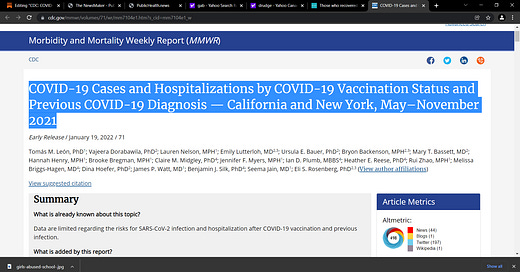
CDC: COVID-19 Cases and Hospitalizations by COVID-19 Vaccination Status and Previous COVID-19 Diagnosis — California and New York, May–November 2021; data is clear to me, why take the vaccine?
It is very clear that those who recovered from Covid-19 (had COVID and cleared it) were less likely than vaccinated to get infected during Delta wave; BOOM!! Not even corrupted CDC can hide it!
Protection from prior COVID-19 infection was better than the protection from COVID-19 vaccines against the Delta virus variant, according to a new study published by the Centers for Disease Control and Prevention (CDC).
Hidden in the report and always a means to push vaccine, but its bogus: why? because you must factor in the toxic side effects and the harms of the vaccine including risk of death…your decision must then skew to no vaccine…even the CDC cant hide it anymore that natural immunity is superior to vaccine immunity…
but silent on the harms of vaccinating on top of natural immunity, yes, we have research that shows if you layer vaccine immunity on top of natural immunity, you are at increased risk of adverse outcomes.
In early October, after Delta became dominant, infection rates among vaccinated people who hadn’t had Covid were 6.2-fold lower than among unvaccinated people who hadn’t had Covid-19 in California, and 4.5-fold lower in New York. People who previously had Covid-19 but had not been vaccinated had 29-fold (California) and 14.7-fold (New York) lower case rates. Vaccinated people who had also had Covid-19 had the lowest rates, with a 32.5-fold (California) and 19.8-fold (New York) lower infection rate than people who had no protection.
Hospitalization rates in California followed a similar pattern, the report says. (There were no hospitalization data from New York.) In October, hospitalization rates for people who’d been vaccinated but hadn’t had Covid were 19.8-fold lower than among those who hadn’t had Covid-19 or been vaccinated. The rates were 55.3-fold lower among unvaccinated people who’d had Covid-19, and 57.5-fold lower among people who’d been vaccinated and had Covid-19.
moreover, the report has several limitations that not even the CDC could not evade and pretend.
Key, any analysis that is not adjusted for co-morbidities is junk:
i) not stratified by time since vaccine receipt, but only by time since previous diagnosis, although earlier studies have examined waning of vaccine-induced immunity (Supplementary Figure 3, https://stacks.cdc.gov/view/cdc/113253)
ii) Second, persons with undiagnosed infection are misclassified as having no previous COVID-19 diagnosis; however, this misclassification likely results in a conservative bias (i.e., the magnitude of difference in rates would be even larger if misclassified persons were not included among unvaccinated persons without a previous COVID-19 diagnosis). California seroprevalence data during this period indicate that the ratio of actual (presumptive) infections to diagnosed cases among adults was 2.6 (95% CI = 2.2–2.9).†††† Further, California only included NAAT results, whereas New York included both NAAT and antigen test results. However, antigen testing made up a smaller percentage of overall testing volume reported in California (7% of cases) compared with New York (25% of cases) during the study period. Neither state included self-tests, which are not easily reportable to public health. State-specific hazard ratios were generally comparable, although differences in rates among unvaccinated persons with a previous COVID-19 diagnosis were noteworthy.
iii) potential exists for bias related to unmeasured confounding (e.g., behavioral or geographic differences in exposure risk) and uncertainty in the population size of the unvaccinated group without a previous COVID-19 diagnosis. Persons might be more or less likely to receive testing based on previous diagnosis or vaccination status; however, different trajectories between vaccinated persons with and without a previous COVID-19 diagnosis, and similar findings for cases and hospitalizations, suggest that these biases were minimal.
iv) this analysis did not include information on the severity of initial infection and does not account for the full range of morbidity and mortality represented by the groups with previous infections.
v) this analysis did not ascertain receipt of additional or booster COVID-19 vaccine doses and was conducted before many persons were eligible or had received additional or booster vaccine doses, which have been shown to confer additional protection.
vi) some estimates lacked precision because of sample size limitations.
vii) this analysis was conducted before the emergence of the Omicron variant, and is limited to Delta…






Imagine how much better natural immunity, and worse the vaccines would look, if they changed the data from “vaccinated” - ie sux weeks post second shot, to simply “at least one shot.”
Considering a huge percentage of people got sick after a jab but before being in the “vaccinated” group, this looks like an indictment of jabs, particularly for the already recovered, which is now almost everyone.